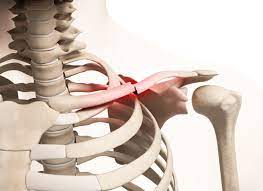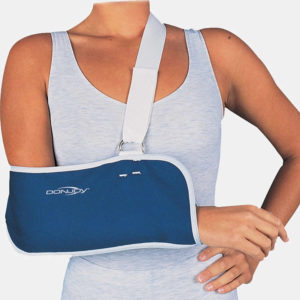Rehabilitation after a Fractured Collarbone

The collarbone, or clavicle, connects the arm to the rest of the body. Its job is to help stabilize the shoulder and arm as they move. A fractured clavicle is one of the most common shoulder injuries. The injury most often occurs from trauma caused by a direct blow or falling. It is most commonly found in young men due to damage that occurs while playing sports. However, it is not uncommon to occur during a fall, especially as people age. A fractured collarbone is very painful and makes it hard to move your arm. Many clavicle fractures can be treated without surgery by using a sling to keep the arm and shoulder from moving so the bone can heal. Although in some cases, surgery may be required to realign the bone because it moved far out of place when the injury occurred.

Types of Fractures
One can suffer three types of fractures. Nondisplaced is where the pieces of the fractured bone line up and can usually heal without surgery. Displaced is the opposite, when the two parts of bones do not line up, requiring surgery. Finally, Comminuted, which will also need surgery, is when splinters or pieces of small bone are at the fracture. In severe cases, fragments of bone can pierce the skin resulting in a compound fracture.
Signs and symptoms
If you break your collarbone, you will feel pain where the break is and throughout your collarbone. In severe cases, you may feel pain radiating throughout your entire arm. Bruising and swelling will also be present at the injury site. Many people lose the ability to lift their arm and hold it tight against their bodies. People also describe a grinding or shifting feeling when they move their arm. There is also likely going to be a bump where the fracture is.
Physical Therapy
Everyone is different, so following a fractured clavicle, you must work closely with your physical therapist to design a rehabilitation program that is specific to you. Physical therapy is designed to help people move again with a full range of motion and strength. Directly after the injury, you will want to keep the injured arm in a sling until your health care provider says otherwise. It is also important to use ice to help reduce pain and swelling. It is also crucial to avoid raising your arm or lifting anything with the injured arm. Finally, it is vital to watch your overall body movement to maintain proper bone alignment. For example, do not slouch or shrug. Three to four weeks after your injury, you may begin physical therapy. The therapist will assess the specific ways they can help you through rehabilitation. They will go over exercises to improve range of motion and strengthening exercises to help restore the lost bone and muscle strength. As you progress with physical therapy, you will increase the intensity of the activities. Full recovery from a fractured clavicle takes time and dedication to your physical therapy program. While you may be anxious to return to normal activities, it is best to follow the directions of your health care team.
Featured Clinician: Anthony Maritato, PT
FEATURED CLINICIAN: Anthony Maritato, PT Anthony Maritato, PT, MSPT, is a licensed physical therapist and co-founder of Total Therapy Solutions, a private practice outpatient physical therapy business that focuses on
Colleen Rapp Wins Friend of Private Practice Award
Long time patient advocate, Colleen Rapp, was awarded the APTA Private Practice Section’s Friend of Private Practice Award during the 2022 PPS conference. Colleen has long been standing up for
Top Tips for Relieving Nerve Pain
Top Tips for Relieving Nerve Pain If you suffer from nerve or neuropathic pain, then you can certainly attest to how it can throw a wrench in your day-to-day routine.
How Your Diet Can Cause Inflammation
How Your Diet Can Cause Inflammation Depending on the situation, inflammation can be a good thing or a bad thing. It is good in that it is your body’s way
What to Avoid After Knee Replacement Surgery
What to Avoid After Knee Replacement Surgery Knee arthroplasty, otherwise known as knee replacement surgery, is designed to relieve pain and restore function in severely diseased knee joints. No matter
How Physical Therapy Can Help You Avoid Reliance on Pain Medications
How Physical Therapy Can Help You Avoid Reliance on Pain Medications If you suffer from chronic pain, you know how managing pain can be a real challenge. Another day, another
Kyle Yancey
Latest posts by Kyle Yancey (see all)
- Top Tips for Relieving Nerve Pain - October 28, 2022
- How Your Diet Can Cause Inflammation - October 25, 2022
- What to Avoid After Knee Replacement Surgery - October 19, 2022
- How Physical Therapy Can Help You Avoid Reliance on Pain Medications - October 13, 2022
- Physical Therapy for Heart Disease - October 11, 2022
